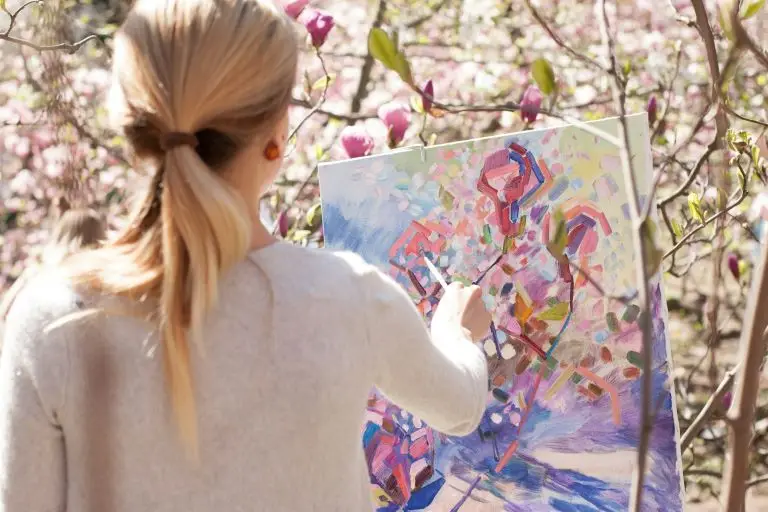Unlock your visionary potential with breathwork for creativity. Learn how conscious breathing techniques like 4-7-8 and alternate nostril breathing can help you overcome mental blocks, reduce stress, and boost creativity.
Creativity is one of our most valuable resources—it fuels innovation, art, and problem-solving. But there are times when inspiration feels distant and creativity seems blocked. If you’ve ever found yourself staring at a blank page or struggling to generate ideas, breathwork might be the missing key. Practicing breathwork for creativity techniques can boost mental clarity, reduce stress, and encourage a state of flow, making it easier to unlock your creative potential.
In this blog, we’ll explore how breathwork can enhance creativity, look at the science behind it, and introduce some simple breathing exercises you can start using today.
What is Breathwork?
Breathwork involves the practice of consciously controlling your breath to influence your physical, mental, and emotional states. Although breathing is something we do automatically, consciously changing our breathing patterns can positively impact our mood, reduce anxiety, and even enhance cognitive abilities like focus and creativity. Breathwork encompasses a range of techniques, from deep breathing exercises to rhythmic breathing patterns, each with unique benefits.
How Breathwork Influences Creativity
Creativity thrives when the mind is free, calm, and open to new ideas. However, stress, anxiety, and mental fatigue are common barriers that inhibit creative flow. Breathwork for creativity addresses these challenges by reducing stress hormones, increasing oxygen supply to the brain, and encouraging a state of relaxed alertness.
1. Reduces Mental Clutter
When we’re stressed, our minds tend to race with thoughts, worries, and distractions. This mental clutter blocks our ability to think creatively. Breathwork activates the parasympathetic nervous system (the “rest and digest” response), which promotes relaxation and reduces the overactivity of thoughts, making it easier to focus on creative thinking.
2. Enhances Focus and Clarity
Conscious breathing increases the flow of oxygen to the brain, improving mental clarity and focus. By engaging in breathwork, you can enter a flow state—a state of heightened focus where ideas come more freely. This mental clarity is essential for brainstorming and problem-solving, especially when working on complex or creative tasks.
3. Opens the Mind to New Perspectives
Breathwork helps reduce rigidity in the mind, allowing you to think outside the box. By calming the nervous system, breathwork can shift you from a “fight or flight” response to a more open, receptive state, where it’s easier to explore unconventional ideas and find new perspectives.
The Science Behind Breathwork and Creativity
Recent studies support the link between breathwork and enhanced cognitive function. Controlled breathing increases oxygen and blood flow to the brain, stimulating the prefrontal cortex—the area responsible for planning, decision-making, and creative thought. Breathwork has also been shown to reduce the levels of cortisol (the body’s primary stress hormone), which can interfere with the brain’s capacity for creative thinking.
A study published in the Journal of Cognitive Enhancement revealed that even brief sessions of mindful breathing could improve creative problem-solving abilities. This research suggests that breathwork can unlock creative potential by fostering a more relaxed, focused, and open mindset.
Breathwork for Creativity Techniques to Boost Creativity
Below are some practical breathwork techniques that can help you tap into your creativity. These exercises can be done anytime you feel blocked or need an inspiration boost.
1. Diaphragmatic Breathing (Belly Breathing)
Diaphragmatic breathing, also known as “belly breathing,” is a simple technique that promotes relaxation and improves oxygen intake. By engaging the diaphragm, you activate the body’s natural relaxation response, making it easier to release stress and focus on the present moment.
How to Practice Diaphragmatic Breathing:
- Sit or lie down comfortably, placing one hand on your chest and the other on your belly.
- Inhale deeply through your nose, allowing your belly to expand as you breathe in.
- Exhale slowly through your mouth, letting your belly fall.
- Continue this deep breathing pattern for 5 to 10 minutes.
This technique can be used at the beginning of a creative session to clear mental clutter and centre your focus.
2. 4-7-8 Breathing
The 4-7-8 technique is a powerful breathwork exercise developed by Dr. Andrew Weil. It’s designed to reduce anxiety, increase relaxation, and foster a sense of calm, making it ideal for creative activities that require focus and imagination.
How to Practice 4-7-8 Breathing:
- Inhale quietly through your nose for a count of 4.
- Hold your breath for a count of 7.
- Exhale completely through your mouth for a count of 8.
- Repeat this cycle 4 to 8 times.
The 4-7-8 breathing technique helps calm the mind and prepares it for a relaxed, creative flow. Use this technique whenever you’re feeling stressed or stuck.
3. Box Breathing (Square Breathing)
Box breathing, also known as square breathing, is a technique often used by athletes and professionals to calm the mind and improve focus. It’s perfect for clearing mental blocks and shifting into a state of creative flow.
How to Practice Box Breathing:
- Inhale through your nose for a count of 4.
- Hold your breath for a count of 4.
- Exhale through your mouth for a count of 4.
- Hold the exhale for a count of 4.
- Repeat this cycle for 5 minutes or until you feel calm and focused.
Box breathing is highly effective for reducing stress and fostering a relaxed yet alert state, perfect for brainstorming sessions or problem-solving tasks.
4. Alternate Nostril Breathing (Nadi Shodhana)
Alternate nostril breathing, or Nadi Shodhana, is a traditional yoga breathing technique that balances the left and right hemispheres of the brain. This technique promotes mental clarity and emotional balance, helping to stimulate creative thinking and idea generation.
How to Practice Alternate Nostril Breathing:
- Sit comfortably and place your left hand on your left knee.
- Using your right thumb, close your right nostril and inhale deeply through the left nostril.
- Close the left nostril with your right ring finger, release your right nostril, and exhale through the right side.
- Inhale through the right nostril, close it, and exhale through the left.
- Continue this alternating pattern for 5 minutes.
Alternate nostril breathing helps clear mental fog and brings a sense of balance, making it ideal for times when you need a fresh perspective or creative boost.
5 Practical Tips for Incorporating Breathwork into Your Creative Routine
1. Create a Dedicated Breathing Practice:
Set aside a few minutes each day for breathwork. Consistent practice can help improve mental clarity and make it easier to access a creative state when needed.
2. Use Breathwork During Breaks:
If you’re working on a project and start feeling stuck, take a 5-minute break to practice one of these techniques. This can help reset your mind and give you a new perspective.
3. Combine Breathwork with Other Mindfulness Techniques:
Pairing breathwork with meditation or journaling can deepen your creative process. Start with a few minutes of breathing, then allow yourself to write or brainstorm freely.
4. Experiment with Timing:
Some people find that breathwork in the morning is helpful for setting a creative tone for the day, while others prefer it during the afternoon to refresh and refocus. Try both to see what works best for you.
5. Stay Consistent:
The more you practice breathwork, the more natural it becomes. With time, you’ll find it easier to access a calm and creative state, whether you’re brainstorming ideas or tackling a complex project.
Summary – Breathwork for Creativity
Breathwork for creativity is a powerful way to unlock creativity, clearing mental clutter, and entering a state of flow. By practicing conscious breathing, you can quiet distractions, reduce stress, and open yourself to new perspectives—qualities that are essential for creative work. Whether you’re writing, designing, problem-solving, or brainstorming, these breathwork techniques can help you tap into your inner creativity and access inspiration more freely.
Creativity isn’t just about skill or talent; it’s about mindset. By incorporating breathwork into your routine, you’re giving yourself the mental space and calm focus needed to let ideas flow naturally. So take a deep breath, relax, and let your creativity soar.
Go here to learn more about my online Meditation Course.
Why not treat yourself to a Meditation Retreat in the beautiful Devon Countryside?
Best Wishes,
David.
© D. R. Durham, All rights reserved, 2024.



